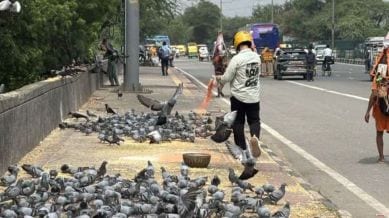Stay updated with the latest - Click here to follow us on Instagram
After ban, BMC plans pigeon-feeding sites at SGNP, Aarey, Wadala and Gorai
At present, Mumbai has over 50 kabutarkhanas, primarily located in the city proper, with a few in the suburban areas

Nearly three months after it banned feeding pigeons in public spaces across Mumbai, the Brihanmumbai Municipal Corporation (BMC) is now considering four potential sites — near Sanjay Gandhi National Park (SGNP), Aarey Milk Colony, a mangrove patch in Wadala, and Gorai — away from dense residential areas, for feeding the birds.
The BMC’s announcement came after a delegation representing members from the Jain community met Mumbai’s municipal commissioner and state appointed administrator Bhushan Gagrani. The delegation of the community demanded the civic authorities to chalk out alternate spaces for pigeon feeding.
monthly limit of free stories.
with an Express account.
“As of now, we are considering four spots where pigeon feeding will be allowed. These include peripheral areas around Sanjay Gandhi National Park (SGNP), Aarey Milk Colony, mangrove patch near Wadala and Gorai. The reason why we chose these places is because they don’t have any residential buildings around so that public health is also not risked,” Gagrani told The Indian Express. He also maintained that in the meantime, all the public feeding spots in Mumbai will remain closed as per the orders of Bombay High Court (HC).
Meanwhile, environmentalists have criticised the civic administration’s move to allow feeding of pigeons inside the SGNP and Aarey Colony, which are eco-sensitive zones. “Pigeons are known to take over nesting spaces of birds such as sparrows and mynahs that are meant to stay around human habitation. So allowing feeding of pigeons inside Aarey forest or SGNP will create huge ecological imbalance,” Stalin D, environmentalist and director of Vanashakti told The Indian Express.
“Pigeon droppings are hazardous and cause pulmonary diseases in humans. Their droppings also spread diseases such as parrot fever, which has a high risk of transmission among wild birds and may contaminate other species. This contamination may spread on other animals who would consume them,” said Dr Rina Dev, an avian veterinarian.
The BMC had earlier acted on the HC’s July 30 order directing the civic body to curb “illegal” and “defiant” feeding of pigeons in public areas such as Dadar West, citing health hazards such as fungal infections and respiratory issues. Following this, the BMC had covered the Kabutarkhanas.
The move met with serious opposition from the Jain community. In several religious communities, feeding of pigeons is considered to be a pious act for which Kabutarkhanas were set up in several parts of Mumbai since the colonial era. These Kabutarkhanas are open public spaces where feeding of pigeons is a regular practice, particularly at major junctions in Mumbai. The Dadar Kabutarkhana, built in 1933, is managed by a local trust and has been a focal point for bird lovers and religious communities.
Amid protests by the Jain community, Chief Minister Devendra Fadnavis announced that controlled feeding of pigeons would be allowed till a final solution was worked out. The civic authorities also invited suggestions and objections from citizens, seeking response on the matter.
In the meantime, the BMC started penalising violators who were found feeding pigeons at public spaces. According to civic officials, between July and October, more than 200 violators were penalised.
The HC had also asked BMC to install CCTV cameras to monitor “mischievous” feeders, depute beat marshals or civic officers at feeding sites, and use nets to prevent pigeons from congregating. In an August hearing, the court reiterated its previous order, stating that since the BMC had not revoked or diluted its decision, the ban on feeding in public spaces “very much stands”. The court, however, allowed the petitioners to apply to the BMC if they intended to feed pigeons, and said the civic body should consider the “larger issue of public health” before taking a decision.
At present, Mumbai has over 50 kabutarkhanas, primarily located in the city proper, with a few in the suburban areas. One of the oldest and best known is the Dadar Kabutarkhana, operated by the Dadar Kabutarkhana Trust.
In Jainism, feeding pigeons is a form of jeev daya or compassion for living beings, one of the central tenets of Jain ethics. Many Jain families and temples organise regular pigeon feeding, often near temples or trust-run Kabutarkhanas. The Dadar Kabutarkhana is one such feeding spot that was set up by a Jain Temple.